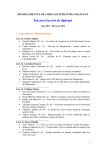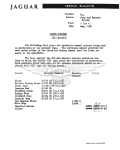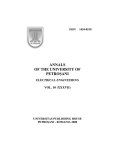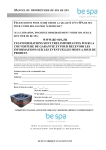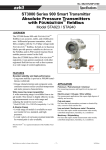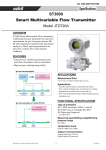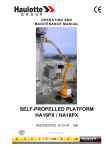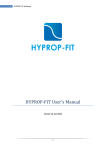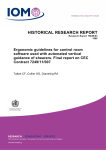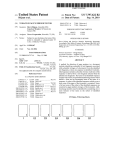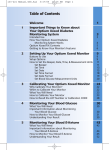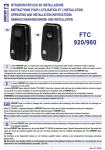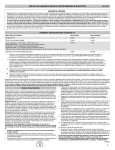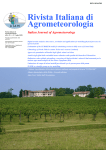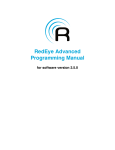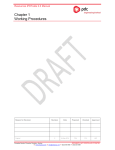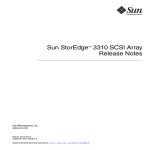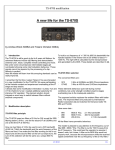Download Data acquisition system for an experimental setup used for
Transcript
INTERNATIONAL JOURNAL OF SYSTEMS APPLICATIONS, ENGINEERING & DEVELOPMENT Issue 6, Volume 5, 2011 Data acquisition system for an experimental setup used for measuring the soil drainage’s parameters Constantin Buta, Carmen Maftei, and Cornel Ciurea Keywords—data acquisition system, drainage physical model, LabVIEW software, soil hydraulic properties estimate the soil water potential during drainage of the soil core [12]. Recent technological developments are demonstrated that the most effective and efficient means of measuring soil water potentials are the tensiometers [10]. In order to reduce analysis time and improve data consistency, an automatic tool to acquisition tensiometer data and their analyses have been developed. We also present a physical model to examine water flow to a subsurface drain and to acquire experimental data [4]. The main purpose of the study was to validate a fast and accurate method for measuring soil drainage’s parameters in which the LabVIEW program from National Instrument is used for the computer management of tensiometers from a physical model. I. INTRODUCTION II. PROBLEM FORMULATION HE purpose of installing subsurface drains in soils is to remove water in order to improve soil physical conditions for environmental protection, for agricultural production and for engineering operations. The problem facing the drainage engineering is therefore one of the physics of water flow through both saturated and unsaturated soils, caused by physical conditions at the soil surface and at the drain peripheries. Knowledge the soil hydraulic properties in order to understanding the behavior of water movement in soil are important for many application of drainage design. The soil hydraulic properties can be characterized by the soil water retention curve, θ(h), and the hydraulic conductivity curve, K(h) or K(θ)[13],[18]. These, can be determined in situ or by laboratory methods [6]. The traditionally laboratory methods to estimate the hydraulic conductivity including infiltration or permeameter tests using constant-head or falling-head configurations on core samples taken from the field site. The pressure plate outflow method (Gardner, 1956) is utilized to A. Theory Before water flow to a subsurface drain through unsaturated soil is discussed, one must first understand the basics of saturated flow. Darcy’s law for one-dimensional steady-state laminar flow of a fluid through a saturated homogeneous, isotropic porous media is: dH (1) q = −K S ⋅ dz where: q (LT-1) - is volumetric discharge rate per unit cross-sectional area (flux); -1 K (LT ) - is the saturated hydraulic conductivity and Abstract—An automated data acquisition system was developed using National Instruments (Austin, TX) hardware and LabVIEW software to understand the behavior of water movement in the unsaturated zone, that lies between ground surface and the saturated zone below, which is important for designing soil drainage. Thus a drainage experiment with a physical model was conducted in laboratory to examine water flow to a subsurface drain and to acquire experimental data about the water flow characteristics of layered soils to serve as a base for numerical analyses. In order to reduce analysis time and improve data consistency, an automatic tool (National Instruments LabVIEW software) to acquisition data and their analyses have been developed. T s dH - is the hydraulic gradient defined as the hydraulic head dz difference between two points in the direction of flow divided by the distance between them, where H is the hydraulic head, equal to the pressure head, h and elevation head, z. In unsaturated soils, Darcy’s law for steady-state flow becomes: dH (2) q = − K (h ) ⋅ dz where the unsaturated hydraulic conductivity, K, is a function of pressure head, K(h), (or volumetric water content, K(θ)). Constantin Buta is with the Faculty of Civil Engineering, Ovidius University of Constanta, Romania (corresponding author to provide phone: +4-0728-040-942; e-mail: costi_buta@ yahoo.com). Carmen Maftei, is with the Faculty of Civil Engineering, Ovidius University of Constanta, Romania (e-mail: [email protected]). Cornel Ciurea is with the Faculty of Civil Engineering, Ovidius University of Constanta, Romania (e-mail: [email protected]). 692 INTERNATIONAL JOURNAL OF SYSTEMS APPLICATIONS, ENGINEERING & DEVELOPMENT Issue 6, Volume 5, 2011 Thus to compute the flux, one must know the value of K(h), which varies with soil water content and consequently pressure head. Due to the increasing capacity of computers, more and more numerical models for the simulation of both saturated and unsaturated soil water flow are being developed and applied[14],[15].[20]. Most of these models are based upon the Richards’ equation: referred to as the air entry value or bubbling pressure, and λ is a pore-size distribution parameter affecting the slope of the retention function. In this study, soil water retention was described by the van Genuchten model [5], one of the widely used models in the specific literature: m 1 (3) S = e n 1 + (αh ) (3) where: h is the soil water pressure head (the negative of matric potential, h ≤ 0), t is time, z is soil depth or the vertical coordinate axis (positive upward), K is the unsaturated hydraulic conductivity and θ is the volumetric water content. Richards’ equation is derived from Darcy’s law for unsaturated soils and the continuity equation. Note that h is a function of z and t, and θ is a function of h, z, and t. The functional relationships between K and h, and θ and h must be known to solve Eq. (3). Equation (3) is a partial differential equation which requires the knowledge of two soil physical relationships: the soil water retention curve (the relationship between water content and pressure head) and the hydraulic conductivity curve (the relationship between hydraulic conductivity and pressure head). These relationships are strongly non-linear and different for each soil-layer. They are very important for obtaining an accurate description of unsaturated water flow and can be measured in the field or in the laboratory using different methods. Hydraulic soil properties are described by functions. A parameter optimization process estimates the parameters. The unsaturated soil hydraulic properties, θ(h) and K(h), are in generally highly nonlinear functions of the pressure head. Data from several soil tensiometers give sufficient information to estimate soil hydraulic parameters. Different analytical models are used for the hydraulic properties [17] (Brooks and Corey, 1964, van Genuchten, 1980, Vogel and Cislerova, 1988, Durner, 1994, Kosugi, 1996), the most popular ones being those by Brooks and Corey (BC model), van Genuchten (VG model) and lognormal pore size distribution model of Kosugi (LN model). The Brooks and Corey model [1] is given by: −λ h (2) S = , h > h , and S = 1, h ≤ h e b e h b b where: θ −θ r - is the effective saturation; S = e θ −θ s r θs and θr are the saturated and residual volumetric water contents, respectively; where: θ - is the volumetric water content (L3L-3); h - is the soil water pressure head (L) and θ , θ , α , n , m - are the parameters to be estimated. r s To reduce the number of parameters and to facilitate the calculation of hydraulic conductivity, the restriction 1 m = 1 − was adopted. n The Kosugi model [7] is given by: ln h h (4) m S = Q e σ where: Q(x) is the complementary cumulative normal distribution function, defined by Q(x)=1-Φ(x), in which Φ(x) is a normalized form of the cumulative normal distribution function. hm - is an empirical parameter whose inverse is often referred to as the air entry value (L-1) Determination of unsaturated hydraulic conductivity by laboratory experiment is time consuming, and therefore researchers have attempted to relate the soil water retention function with the unsaturated hydraulic conductivity (Fig.1). θ 0 θ (z ) van Genuchten model ∂θ (h) ∂ ∂h = K ( h) − K (h) ∂t ∂z ∂z hb (L-1) is an empirical parameter whose inverse is often z h k ks Darcy's law k (θ ) 0 h(θ ) 0 θr θs θ θ Fig.1 Algorithm to relate the soil water retention function with the unsaturated hydraulic conductivity 693 INTERNATIONAL JOURNAL OF SYSTEMS APPLICATIONS, ENGINEERING & DEVELOPMENT Issue 6, Volume 5, 2011 Hydraulic conductivity can be described by the Mualem van Genuchten equation (van Genuchten, 1980) [2]: 2 m 1 m (5) L K ( S ) = K S 1 − 1 − S e e s e where: θ −θ r - is the effective saturation; S = e θ −θ s r -1 K is the saturated hydraulic conductivity(LT ) and 100 90 10 80 20 70 30 1 60 clay 40 50 50 silt 2 4 4.1 4.2 40 60 1.1 1.2 6 2.2 30 3 2.1 70 0.2 0.1 5 20 80 9 3.1 3.2 8 12 10 90 11 7 10 0 100 90 100 80 60 70 40 50 10 20 30 0 sand s Fig. 2 User defined scheme for soil texture classes L is the parameter of tortuosity. Soil texture is quantified by the relative percentages by mass of sand, silt, and clay after removal of salts and organic matter. B. Soil data analyses Tests on undisturbed soil samples were used to verify the new data acquisition system capabilities. Samples were collected from an experimental site located in Eforie Sud area, Constanta. The soil profile was limited to four layers. In the drainage box we tried to keep the sequence of the natural soil layers and the ratio for soil depth (Table I). fracŃiuni % 0 0 20 Layer Layer type 0 I Ame Bt Layer depth (cm) 0-20 20-60 II Ao 60-80 10YR6/2 III Btx 80-120 10YR6/6 IV C >120 10YR4/6 Munsell Indicator 10YR3/2 10YR4/2 10 20 30 40 50 60 70 80 90 100 PL PL 40 LAP z (cm) LAP Table I Soil profile characteristics Soil profile USDA: 1: clay 2: silty clay 3: silty clay loam 4: sandy clay 5: sandy clay loam 6: clay loam 7: silt 8: silt loam 9: loam 10: sand 11: loam y sand 12: sandy loam 0 Soil texture classes Silt loam Silty clay loam Clay loam Silt loam 60 80 100 120 140 LP AL N P A PL PL LA AL Fig. 4 Particle size distribution on soil profile (N-sand, P-silt, A-clay) Both texture and structure determine the soil-water characteristic curve, which quantifies the relationship between soil water content and soil water potential, which is the strength with which the soil holds water and are important in drainage system design. This relationship differs largely according to texture, but can be strongly affected by organic matter and salt contents. Soil bulk density is the oven dry weight of soil divided by the soil volume. Units are g/cm3 (Fig.3). Silty clay loam In addition to soil layer thickness and orientation, the water flow simulation requires information on the hydraulic properties of each layer. First, a number of attempts were made on the soil samples collected in order to determine its physical and hydraulic parameters. The tests were made in the Physical Soil Laboratory of the Civil Engineering Faculty of Constanta and the results can be seen in the following paragraphs. Measured data include particle size distributions, particle density, dry bulk density, soil water content characteristics and saturated hydraulic conductivity. The particle size analysis was done with the hydrometer analysis method. To determine soil texture classes we used Texture AutoLookup (TAL) for Windows, a program based on several major soil classification schemes, including custom (userdefined) schemes. Using the user-defined scheme (Fig 2) we have determined the soil texture type for each layer. ρa ρ ρ (g/cm 3) 1.00 1.20 1.40 1.60 1.80 2.00 2.20 2.40 2.60 0 1.69 1.59 10 20 30 1.75 1.96 40 I 50 z (cm) 60 70 80 1.63 II 1.81 90 100 1.89 2.07 III 110 120 130 1.60 1.72 IV 140 150 Fig. 3 Soil density (ρ) and dry bulk density (ρa) on soil profile 694 INTERNATIONAL JOURNAL OF SYSTEMS APPLICATIONS, ENGINEERING & DEVELOPMENT Issue 6, Volume 5, 2011 water through the microscopic pores in the ceramic plate, and through the outflow tube towards the outlet of the pressure plate. During an extraction run, at any given air pressure established in the apparatus, soil moisture flowed from around each of the soil particles and out through the plate until the curvature of the water film throughout the soil was the same as the pores in the plate. When this occurred, equilibrium was reached and the water flow ceased. Wet samples were weighed after removal from the plate, and oven was dried at 105 C during 24h. Samples were weighed again, and water content was obtained. For illustration the result of water retention curves for soil layer I and soil layer III are shown in Fig. 6. The bulk density of a soil is related to a textural class and organic matter content. Bulk densities typically range from less than 1 g/cm3 to nearly 2 g/cm3. Bulk densities less than 1 g/cm3 are often soils that contain large amounts of organic matter. Clayey soils tend to have the smallest bulk densities of mineral soils, while sandy soils have the highest bulk densities. Silty soils are intermediate. Actual soil weights also include water. To determine in the laboratory the initial water content on the soil profile, the gravimetric method was used. Soil water content profile is illustrated in the following figure. θ (%) 0.00 0 10 5.00 10.00 15.00 20.00 25.00 Curba caracteristică a umidităŃii θ (h) Orizont I (sol lut argilo prăfos) 10.21 20 30 40 1.2 13.96 I 1 LAP h(bar) 50 z (cm) 60 70 80 11.02 II 110 0.6 0.4 LP 0.2 90 100 y = -16.003x 3 + 15.345x 2 - 5.4148x + 0.9258 R2 = 0.929 0.8 16.73 III 0 PL 0 0.1 0.2 120 3 0.4 0.5 0.6 3 θ (cm /cm ) 130 140 0.3 IV LAP 18.29 Curba caracteristică a umidităŃii θ (h) Orizont III (sol praf lutos) 150 Fig. 4 Soil water content variation 1.2 In the laboratory, the water retention curves were measured with a pressure plate apparatus, using the equipment from the Geotechnical laboratory of the Faculty of Civil Engineering, whose schematic is shown in Fig.5. 4 h(bar) 3 2 y = 97.456x - 49.652x - 2.8151x + 0.351x + 0.9974 1 2 R = 0.9999 0.8 0.6 0.4 0.2 Air pressure Presiune aer 0 0 Esantion de sol Soil sample 0.1 0.2 0.3 0.4 0.5 3 3 θ (cm /cm ) Fig. 6 Soil water characteristic curve for soil layer I (up) and soil layer III (down) Placă poroasă Porous plate The saturated hydraulic conductivity was measured for every type of soil layer (horizon) using undisturbed cylindrical samples, with 2 cm high and 5,6cm in diameter. For this test we have used a constant head permeameter without suction (Fig. 7). Ieşire Out flow Fig. 5 Pressure plate apparatus scheme To compare the automated measurements taken with the tensiometers, estimations of soil water content were conducted first on the pressure plate by using the following methodology. Soil samples were placed on a porous plate held in 2cm high rings. Then, samples and plate were saturated with water (24h). Once the porous plate and the samples were completely saturated with water, the plate was installed, and air pressure was used to extract moisture from soil samples under controlled conditions. As soon as air pressure was raised above atmospheric pressure, the higher pressure inside the chamber forced excess Fig. 7 Constant head permeameter without suction 695 INTERNATIONAL JOURNAL OF SYSTEMS APPLICATIONS, ENGINEERING & DEVELOPMENT Issue 6, Volume 5, 2011 Once the saturated hydraulic conductivity was measured, we used the algorithm to relate the soil water retention function with the unsaturated hydraulic conductivity from Fig 1. Thus, we determined the hydraulic conductivity curve (Fig. 8). C. Experimental setup In the experimental drainage model setup had been considered the following directions: • Establishment of the artificial rain simulator; • Drains installation; • Establish the physical properties of soil under natural conditions; • Establish the parameters of the artificial rain; • Procedures for verification and calibration of measuring instruments; • Management of the data acquisition and computer system. The drainage physical model [4], [7] consists of a metal box with the frontal wall from 10mm glass, mounted on a metal substrate and having the following dimensions: 3000 (L) x1000 (H) x200 (L) mm (Fig. 9). Curba conductivitate hidraulică-umiditate volumică: K(θθ ) Orizont I (sol lut-argilo-prăfos) 0.0006 Ks(θθ s) 0.0005 Ks=5.29*10-4 K(cm /s) 0.0004 0.0003 Κ(θ) 0.0002 0.0001 θ s=0.52 0 0 0.1 0.2 0.3 0.4 0.5 0.6 θ (cm 3/cm 3) Curba conductivitate hidraulică-umiditate volumică: K(θθ ) Orizont III (sol praf lutos) Alimentation Pressure control 0.0006 Ks(θθ s) K(cm/s) 0.0005 Acquisition systems for watermeter Acquisition systems for tensiometer Watermeter Rain simulator (drip system) Ks=4.83*10-4 0.0004 0.0003 Κ(θ) 0.0002 0.0001 θ s=0.41 Layered soil profile 0 0 0.1 0.2 0.3 0.4 0.5 PC θ (cm 3/cm 3) Drain Piezometric table Fig. 9 Laboratory drainage box (physical model) Fig. 8 Hydraulic conductivity curve for soil layer I (up) and soil layer III (down) The front side of the model is transparent to facilitate visual observations and photography. The rain simulator is designed as a drip system (Gardena micro irrigation system) which consists of two lines with 10 dropping on the line (one dropper has a capacity of 2l/h). Thus, precipitation may be given an intensity of 70mm/h, which creates water excess. [19], [22]. At the same time it can be given different volumes of water, meaning that can manage an intensity of 35mm/h. At the bottom of the physical model there are two drains screwed in the front wall of the tank. One drain is from corrugated PVC with diameter about 50 mm, the other looks like a rigid spiral tube with diameter of 50mm. Drains are set at 50 mm from the tank bottom and from the side wall to minimize the influence of the boundary conditions (infiltration besides the tank walls). These two drains will produce the pattern of distance between the drains of 6 m and 3 m respective, and will function as a drain or two drains. Drains are provided with valves to control the operating mode of the model. To prevent clogging, the drains are wrapped with geotextile. The drainage box bottom is provided from 10 to 10 cm with piezometric outlets protected by a geotextile. Piezometer capillary tubes made of PVC are caught on a piezometric table. This resulted in a total of 54 piezometric tubes. The model is equipped with a set of eight tensiometers SKT All the experimental laboratory results are summarized in Table II. Table II Physical and Hydraulic properties of the experimental soil Soil properties Layer depth (cm) 0 I II III IV 0-20 20-60 60-80 80>120 120 Particle 2.5 2.52 2.65 2.68 2.65 density (g/cm3) Bulk density 1.59 1.75 1.63 1.89 1.60 (g/cm3) Clay 24.2 35.6 29.1 14.7 31 content(%) Silt content(%) 51.8 44.5 44 53.1 48 Sand 24 19.9 26.9 32.2 21 content(%) Saturated 37.1 30.4 38.3 29.5 38.7 water content θs(%) Residual water 5.85 6.34 6.32 5.23 content θr(%) Saturated 5.29 5.03 4.12 4.83 hydraulic conductivity Ks(10-4cm/s) 696 INTERNATIONAL JOURNAL OF SYSTEMS APPLICATIONS, ENGINEERING & DEVELOPMENT Issue 6, Volume 5, 2011 850T - SDEC France (Fig. 10) with pressure transducers (0100mV), introduced by the back side of the tank and arranged in three vertical sections of the model, at equal distances and at various depths (20 cm and 40 cm). Senzor 8571133 Presiune (hPa) 0 -1.4 -1.2 -1 -0.8 -0.6 -0.4 -0.2 0 -200 y = 508.61x + 54.802 -400 2 R = 0.9985 -600 -800 Tensiune (mV) Presiune-Tensiune Linear (Presiune-Tensiune) Fig. 13 Calibration equation for tensiometer D. Experimental protocol We have taken account of the following methodologies to establish a functioning drainage in the physical model [11]. 1. The dry soil will be crushed in particle with the size of diameter of Φ<10mm. 2. Placing and compacting soil samples in the drainage model are made in layers of about 2030cm thickness. 3. For mixing and plugging between the layers, the compacted soil surface is furrowed before introducing a new layer 4. We avoid placing a filter layer of sand or graveling on the drainage box bottom because this will modify the conditions of the water flow to the drains. Regarding the experimental protocol will do so: 1. at the beginning the model will operate as a constant head permeameter: • the soil from the model is saturated by applying a constant volume of water; • the piezometric tubes are checked for removing the air from the tubes with a vacuum pump; • the volume of water which percolate the soil profile is colected and measured at fixed time steps and when we get the same volume of water, than the piezometric tubes are connected to the piezometric tableau. • will wait until the water level in the piezometric tubes is establish and after that it is made the first measurement of water depth in soil. • the pressure head data in soil are measured with the tensiometers (SDEC) and soil moisture data is obtained with soil moisture meter (Watermark) • it is measured the wetting time of each layers. 2. determining the volume of water drained through the PVC corrugated tube in steady and unsteady state: • it is measured the time from when the rain begin to the moment when the drain start to function; • it is measured the drain discharge at different time period (5min, 15, 30min); • it is read the piezometers at each measurements of drain discharge; Fig. 10 Tensiometer SKT 850T (SDEC France) These eight tensiometers fitted with pressure transducers will be attached to a central box of data acquisition (data acquisition system with two SCXI modules from National Instruments) which is connected to a computer (Fig. 11). Fig. 11 Data acquisition system (DAQ) with two SCXI modules For the computer management of tensiometers we have used the LabVIEW program [8], whose front panel is presented in Fig. 12. Fig. 12 Front panel for Labview platform program Output voltage of the tensiometers is automatically converted into units of pressure head (hPa) using the calibration equations, experimentally determined (Fig.13), based on the certificate issued by the manufacturer. The measurement range of this sensor is 0 hPa (mbar) to -950 hPa. 697 INTERNATIONAL JOURNAL OF SYSTEMS APPLICATIONS, ENGINEERING & DEVELOPMENT Issue 6, Volume 5, 2011 France with pressure transducers (0-100mV), are introduced by the back side of the drainage box (Fig. 16) and arranged in three vertical sections of the model, at equal distances and at various depths (20 cm and 40 cm). it is also read the tension indicated by the tensiometers. III. PROBLEM SOLUTION Using LabVIEW graphical system design software[8], [9], we built an application that consists of a customized user interface, a display interface for the follow-up, and a recording. The data we had to acquire includes a variety of soil hydraulic parameters. National Instruments LabVIEW software is used for instrument control and automation. A single programming code, or “virtual instrument” in LabVIEW, includes a block diagram (Fig. 14) and a front panel. The block diagram contains graphical representations of functions to read from, or write to an instrument (e.g., pressure transducer or valves). 20 timp (ore) 0 23.08.201 23.08.201 23.08.201 23.08.201 23.08.201 23.08.201 24.08.201 24.08.201 -20 0 09:36 0 12:00 0 14:24 0 16:48 0 19:12 0 21:36 0 00:00 0 02:24 -40 T1 T5 h (cm) • T4 -60 h(t):T1-T4 h(t):T5-8 -80 -100 -120 -140 T8 -160 Fig. 16 Tensiometers location on physical model and tensiometers record at time A data acquisition system (DAQ) is programmed to scan the transducers at selected intervals and record the information. The information is then transferred to a computer for calculations and plotting of soil water potential with time (see Fig. 16). A. Characterization and parameter estimation When the soil water potential measurement is combined with a soil water content measurement, a soil water retention curve is obtained. Soil water retention curve on physical model Horizon I (5-30cm) Suction |h| (cm) 1000 Fig. 14 LabVIEW block diagram The front panel (Fig 15) is the user interface, which has controls for selecting test parameters that depend on the test method selected. Four commonly used MSO testing regimes are supported by the LabVIEW control code; for each, the following data are displayed on the computer screen and written to a spreadsheet file: tensiometer reading, water volume in the burette, elapsed time, and laboratory room temperature. 100 10 Tensiometer1 1 0.1 0.01 0.001 0 0.1 0.2 0.3 0.4 0.5 Volumetric water content (cm3/cm 3) Fig. 17 Soil water retention curve Soil from drainage model was also drained and re-wetted with the automatically read of tensiometers to demonstrate the effects of hysteresis on soils. Hysteresis effect (Fig.18) is defined as the phenomena by which a soil’s water content will be greater during drying rather than re-wetting at a given soil water pressure head. Water retention curve - hysteresis effect- Suction |h| (cm) 1000 100 10 wetting 1 drainage 0.1 0.01 0.001 Fig. 15 Front panel for Labview platform program - Pressure head measurement 0 0.1 0.2 0.3 0.4 0.5 Volumetric water content (cm3/cm3) First the system will automatically read soil tensiometers. Each tensiometer uses a vacuum transducer whose output voltage varies linearly with the amount of tension in the tensiometer. All the eight tensiometers SKT 850T - SDEC Fig. 18 Hysteresis effect on the water retention curve To compute soil water fluxes in unsaturated soils, a common approach is to numerically solve the Richards equation, which 698 INTERNATIONAL JOURNAL OF SYSTEMS APPLICATIONS, ENGINEERING & DEVELOPMENT Issue 6, Volume 5, 2011 Table IV Parameters obtained from the fitting of water retention curve for layer III usually requires the parameterization of the soil water retention curve. There are two main approaches for obtaining the soil water retention parameters: the first is to experimentally determine the soil water retention and fit a water retention function to the experimental data (e.g., Brooks and Corey, 1966; Campbell, 1974; van Genuchten, 1980; Vogel and Cislerova, 1988; Durner, 1994; Kosugi, 1996), and the second is to derive the soil water retention parameters from knowledge of basic soil physical properties by using pedotransfer functions (Rawls et al., 1982; Leij et al., 1996; Schaap et al., 1999, 2001; Acutis and Donatelli, 2003). The parameters obtained from the fitting of water retention curves are listed in Table III, Table IV and the corresponding water retention curves are shown in Fig.19 and Fig.20. Only the results for layer I (from 20 to 60cm) and III (from 80 to 120cm) are shown: the results from other soil depths in the stand model were similar. Fitting result are presented in Table III and Table IV. Model Brooks and Corey (1964) Equation Parameters −λ θ h s = 0.31875 , h > h θ = 1.0409eS = r e h b b 05 hb = 100.23 λ = 0.40396 S = 1, h ≤ h e van Genuchten (1980) 0.769 b 1 S = e n 1 + (αh ) m (m=1-1/n) Kosugi (1994) R2 ln h h m S = Q e σ θs = 0.29321 θr = 1.1759e05 α= 0.0024229 n = 1.9154 θs = 0.31750 θr = 1.6772e06 hm = 722.71 σ = 1.8475 0.861 0.827 0.35 0.3 Table III Parameters obtained from the fitting of water retention curve for layer I Equation h S = e h b Brooks and Corey (1964) Parameters ,h > h b 1 S = e n 1 + (αh ) m (m=1-1/n) ln h h m S = Q e σ Kosugi (1994) R2 −λ S = 1, h ≤ h e b van Genuchten (1980) Volumetric water content (cm3/cm3) Model 0.25 θs = 0.40328 θr = 3.1021e07 hb = 99.421 λ = 0.87780 0.15 0.911 0.981 θs = 0.39777 θr = 1.5789e06 hm = 279.80 σ = 0.75280 0.984 1 Volumetric water content (cm3/cm3) 0.2 measured BC model VG model LN model 0 Pressure head (cm) 100 100 1000 A fast and accurate method for measuring retention curves has been developed in which the LabVIEW program is used for the computer management of tensiometers from a physical model. This LabVIEW-based test system has been an effective development and checkout tool for our laboratory drainage box. This type of testing would have been a difficult task without LabVIEW, which simplified data collection and analysis, decreased testing time, and reduced the amount of operator interruption. LabVIEW also eliminated the need for separate data acquisition, spreadsheet, and mathematical software packages. With its numerous features, LabVIEW made implementing this new test and measurement method easy. Regarding the parameters obtained from the fitting of water retention curve, from the figure and table we get the impression that VG and LN models give better fitting than BC model on average, while VG and LN models are not so different in precision of the fitting. The h( θ ), K( θ ) functions had been established with accuracy and the results are global 0.25 10 Pressure head (cm) IV. CONCLUSION 0.3 1 10 Fig. 20 Fitting of water retention curve (soil layer III) 0.35 0.05 VG model LN model 0 θs = 0.38583 θr = 5.1546e07 α = 0.0043884 n = 2.7678 0.4 0.1 measured BC model 0.1 0.05 0.45 0.15 0.2 1000 Fig. 19 Fitting of water retention curve (soil layer I) 699 INTERNATIONAL JOURNAL OF SYSTEMS APPLICATIONS, ENGINEERING & DEVELOPMENT Issue 6, Volume 5, 2011 [18] M. Th. Van Genuchten, F.J. Leij, and S.R. Yates, “The RETC Code for Quantifying the Hydraulic Functions of Unsaturated Soils”, Robert S Kerr Environmental Research Laboratory, U.S. EPA, pp92, 1991. [19] A. Bărbulescu, E. Pelican, “On the Sulina Precipitation Data Analysis Using the ARMA models and a Neural Network Technique”, Recent Advances in Mathematical and Computational Methods in Science and Engineering, Proceedings of the 10th WSEAS International Conference on Mathematical and Computational Methods in Science and Engineering, MACMESE’08, Part II, Bucharest, 2008, pp.508-511. [20] A. Bărbulescu, C. Gherghina, Mathematical modeling of the water retention in different soil textural type, Bull. For Applied & Computer Mathematics (XCVI – C), Technical University of Budapest, 2001 pp. 23 – 30. [21] Schaap M.G., F. J. Leij and M. T. van Genuchten, “A bootstrap neural network approach to predict soil hydraulic parameters” In Characterization and measurement of the hydraulic properties of unsaturated porous media. Part 1. (Ed. M.Th .van Genuchten et al.) Univ. of California, Riverside 1999. [22] A. Bărbulescu, E. Băutu, “Meteorological Time Series Modelling Based on Gene Expression Programming, Recent Advances in Evolutionary Computing, Proceedings of the 10th WSEAS Int. Conf. on Evolutionary Computing (EC’09), Prague, Czech Republic, March 23 – 25, 2009, pp. 17 – 23. satisfactory. In this work, a user friendly, easily-assembled, automated data acquisition system was designed and built using National Instruments (Austin, TX) hardware and National Instruments LabView software and validated via comparisons with manual laboratory outflow test results. The resulting device eliminates several problems related to manual testing and allows for several undisturbed or reconstituted soil samples to be tested. The system is capable of saturating, draining, and re-wetting samples so that drainage and wetting soil characteristic curves can be developed in its current configuration. Future work should include more experiments to confirm the applicability of the data acquisition system and LabVIEW applications for subsurface drainage systems calculus. REFERENCES [1] [2] [3] [4] [5] [6] [7] [8] [9] [10] [11] [12] [13] [14] [15] [16] [17] R.H. Brooks, and A.T. Corey, “Hydraulic properties of porous media” Hydrol. Paper 3. Colorado State Univ., Fort Collins, CO, USA, 1964. C. Buta, C. Maftei, C. Ciurea, C. Bucur, L. Bălaşa, “Using NI LabVIEW to automate analyses of water flow to a subsurface drain in a layered soil”, Computational Engineering in Systems Applications (Vol II), Proceedings of International Conference on Energy, Environment, Economics, Devices, Systems, Communications, Computers, IAASAT, pp. 125-130, Iaşi, iulie 2011. C. Buta, C. Maftei, - Analysis of hydrodimamics properties of soils in a laboratory tank model, Lucrări ştiinŃifice, Anul XLIX Vol I, Seria Horticultură, Ed. Ion Ionescu de la Brad, Iaşi, 2008. C. Buta, “Cercetări privind tehnica şi tehnologia drenajului superficial coroborată cu folosinŃa terenului amenajat”, teza de doctorat, 2010. M. Th. van Genuchten, “A closed-form equation for predicting the hydraulic conductivity of unsaturated soils.” Soil Sci. Soc. Am. J.44:892-898, 1980. C. Kao, “Fonctionnement hydraulique des nappes superficielles de fonds de vallées en interaction avec le réseau hydrographique”, These pou obtenir le grade de docteur, ENGREF, Paris, 2002. K. Kosugi, “Lognormal distribution model for unsaturated soil hydraulic properties.” Water Resour. Res.32: 2697-2703, 1996. National Instruments Corp, LabVIEW User Manual, Austin, Texas, U.S.A. April 2003 Edition. National Instruments Corp, “LabVIEW Development Guidelines” Austin, Texas, U.S.A. April 2003 Edition. A. Paris, ‘Etude du transfert d’eau et de solutes dans un sol a nappe superficielle drainee artificiellement.’ These pou obtenir le grade de docteur, ENGREF, Paris, 2004. E. Nitescu, “Contributii la studiul drenajului in scop de desalinizare si de prevenire a salinizării secundare în masivele irigate”, IP Iaşi 1980. [2] A. Musy and M. Soutter, Physique du sol. Press polytehnique et universitaires romandes, Lausanne, pp1-335, 1991. Vogel and M. Cislerova, “On the reliability of unsaturated hydraulic conductivity calculated from the moisture retention curve” Transp Porous Media 1-15, 2001. K. Seki, “SWRC fit a nonlinear fitting program with a water retention curve for soils having unimodal and bimodal pore structure” Hydrology and Earth System Sciences 4, 407-437, 2007. M.G. Schaap, F. J. Leij and M. T. van Genuchten, “Rosetta: A computer program for estimating soil hydraulic parameters with hierarchical pedotransfer functions” Journal of Hydrology 163-176, 2001. C. Maftei, A. Bărbulescu, C. Buta, C. Şerban, “Change points detection on variability analysis of some precipitation series”, Recent Researches in Computational Techniques, Non-Linear Systems & Control, pp. 232237, 2011. M. Carmen, C. Buta, “Evaluation of the Mathematical Models for Quantifying the Unsaturated Hydraulic Conductivity”, Lucrări ŞtiinŃifice, anul XLIX, Vol 1(49), seria Horticultură, ed. “I.I. Brad”, pp.951-957, 2007. 700










